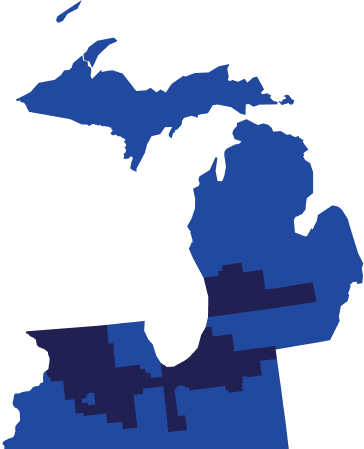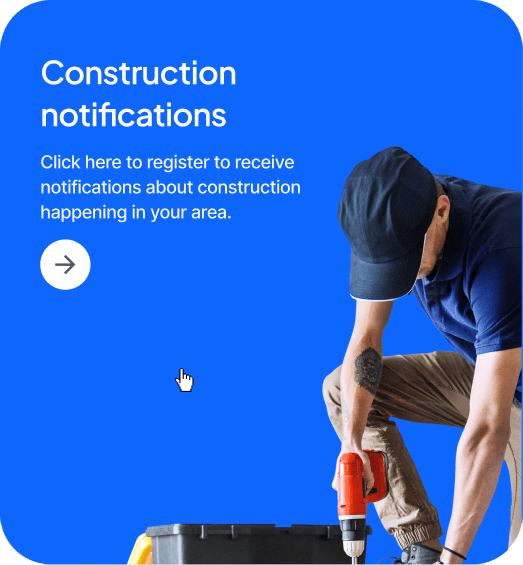Surf Internet Construction
Explore regions where construction is active or completed

View information about our construction projects and where our regional office is located.
Get answers to your
construction questions
Does Surf Internet have a right to be on my property?
In places where fiber-optic is being constructed, Surf Internet will always have an easement and legal right-of-way to be on private property that is granted in advance by the local government by a permit for the specific purpose of carrying out the construction of fiber. Because of this, we ask property owners to do their best to work with us in letting us know of any underground hazards we may need to know about and to let us know of any other concerns immediately so that they may be addressed accordingly.
What is an “Easement” or “Right-of-Way”?
Your local government owns the legal right to access specific portions of your property to access and maintain municipal utilities. Service providers, such as Surf Internet, get permission to use these in the form of easements, a permanent restriction on the property that transfers in ownership if the property is ever sold. Having an easement allows us the right to use the land for specific purposes, but we do not retain ownership of it.
A right-of-way is a type of easement that allows the user the right to make way over a piece of land for the express purpose of creating an avenue of public travel (roads, bridges, canals, etc.), or in this case public utilities, fiber-optic internet.
How long do I need to leave flags in my yard?
Markers and paint need to remain in place until the construction is done. The construction crews rely on these markers to tell them where important existing services are in the easements; thus, removing them may cause a larger problem by hitting existing utilities such as water, gas, and electricity.
What about yard restoration?
Our crews will make every effort to minimize the impact to your property during our fiber-optic internet construction. Once construction has concluded in front of your home and weather permitting, Surf Internet will restore lawns in places where digging, or plowing has occurred within about two weeks. A typical restoration will take the following steps to restore your property where hand holes or vaults were installed.
- Add dirt to level the ground
- Seed area for new grass
- Lay Straw
- Install a compostable mesh to hold seed and straw.
If you have any questions or concerns about your yard or the area impacted by fiber-optic internet construction in front of your home, please fill out the form here.
Sprinklers, dog fence, sump pump?
It is essential that you notify us of these items in advance so that we can take steps to avoid them. They can be marked with either landscaping flags or landscape-safe paint. Please use pink paint. The flag colors listed below are for utility purposes.
Fill out the Private Lines Form here, or call us at 855-772-0993.
- Blue: Potable Water
- Green: Sewer and Drain Lines
- Orange: Communication, Alarm or Signal Lines, Cables or Conduit
- Pink: Temporary Survey Markings
- Purple: Reclaimed Water, Irrigation and Slurry Lines
- Red: Electric Power Lines
- White: Proposed Excavation.
- Yellow: Natural Gas, Oil, Steam, Petroleum
What's the construction overview?
Surf Internet typically installs our fiber-optic cables in an easement that each city, county, or state has established for utilities to install their services.
1. Permitting
Each new fiber-optic construction plan needs to be approved by the state or local agency that regulates construction within their jurisdiction. This can include, state highways, county easements, cities, railroads, and various others. Permits, based on their complexity and how many existing utilities are already present can take anywhere from a few days to be approved to months.
2. Underground
The underground stage is the process of pulling conduits in the ground once the permits and final fiber-optic paths have been established. The two main ways of accomplishing this are with a plow or a directional boring machine. Along with conduit, fiber-optic hand holes are also installed in the underground phase that allows technicians access to the backbone for circuit installations.
3. Fiber-Optic Cable Pull
After all of the underground work, the fiber-optic pulling team installs the backbone fiber-optic within the conduit leaving access for the splicing crew to pull enough slack to service the fiber-optic in the future. This process can either be a manual “pull” using a string attached to the cable or advanced using a blowing machine that can send the cable through a feeding system.
4. Splicing
Splicing fiber-optic takes a well-trained technician to break open the cable and attach other fiber-optic to the backbone. There are various ways our technicians accomplish this using fusion splicing primarily. Splice cases are installed for customer access and to either bypass or light sections for various types of access.
5. Backbone Complete
Once all stages of the physical construction have been completed, our network engineers can install various types of electronics to service customers and send data over the newly installed fiber-optic. Complete only refers to the stage of getting the backbone fiber-optic ready for customer access and does not mean the fiber-optic is lit yet. It does mean the fiber-optic construction crew is on to the next project that has passed the permitting stage and is ready to start the underground process in a new location.
6. Ready for Customers
After the newly installed backbone has been completed, our fiber-optic installation technicians are ready to install a fiber-optic connection into your home and bring the fastest internet to your home or business.
How long will it take to Install Fiber-Optic Internet?
Surf fiber-optic internet is available in various locations in Illinois, Indiana, and Michigan. For homes in areas we serve, we strive to bring fiber-optic as quickly as possible, but depending on the location, permitting process, and construction process it can take several months. Our goal is to provide you with as much information as possible about availability in each city we will offer services in.
Building the Surf fiber-optic network requires laying hundreds of miles of new fiber-optic cable that can support any home or business with the fastest Internet. Currently, only a handful of homes in the country have the option for fiber-optic internet, but we are doing our part to change that and appreciate your interest. Signing up, or checking if your home can get service is easy, just go to iwantfiber.today.
Each home we build pass will have the option to connect to the network. It’s extremely important for us to know if you are interested so we can accurately design and install enough access.


